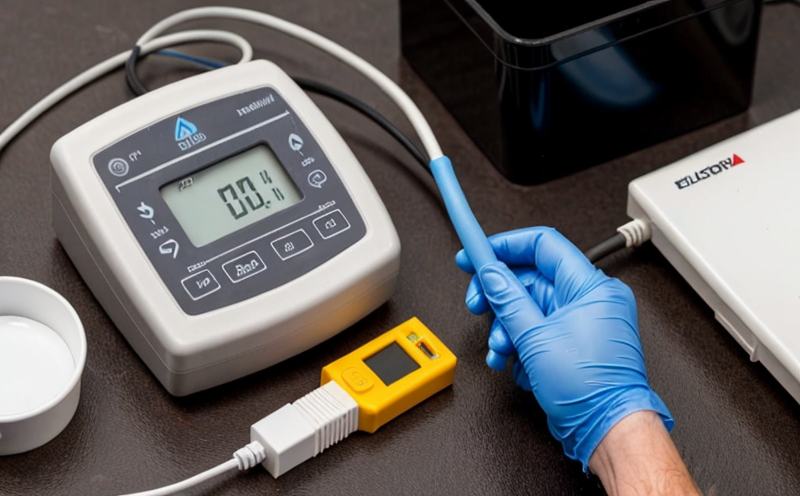ISO 17475 Electrochemical Potentiodynamic Polarization Testing
The ISO 17475 standard specifies the procedure for performing potentiodynamic polarization testing (PDP), a widely used technique to evaluate corrosion resistance in metals and alloys. This method is particularly useful in industries where materials must withstand harsh environments, such as marine, petrochemical, and aerospace sectors.
The test involves subjecting metallic specimens to an electrochemical potential sweep while measuring the current response. The primary goal is to determine a material's susceptibility to pitting corrosion under various conditions. This information can be crucial for selecting appropriate materials in corrosive environments or for monitoring changes in material properties over time.
During potentiodynamic polarization testing, the specimen is immersed in an electrolyte solution, typically sodium chloride (NaCl) or another relevant saltwater environment. The test cell consists of a reference electrode, working electrode, and counter electrode. The working electrode is the sample being tested, while the reference and counter electrodes ensure stable electrical conditions.
The testing process begins by setting up the potential sweep range, which defines the voltage limits between the start and end potentials. Common ranges are from -1 V to +1 V relative to a saturated calomel electrode (SCE). The test is conducted in a controlled environment, often at room temperature or specific elevated temperatures.
The current response is recorded as a function of potential over the entire sweep range. From this data, several key parameters are derived:
- Corrosion Current Density: Indicates the amount of corrosion occurring on the specimen surface.
- Pitting Tendency: Determines if pitting corrosion will form under specific conditions.
- Critical Pitting Potential (CPP): The potential at which pitting begins to occur. This is a critical parameter for material selection.
The test results are then analyzed using statistical methods to ensure accuracy and reliability. These results can be used in conjunction with other testing methodologies, such as immersion tests or weight loss measurements, to provide a comprehensive understanding of the specimen's corrosion resistance.
| Parameter | Description | Unit |
|---|---|---|
| Corrosion Current Density | The current density measured during the polarization test. | A/m2 |
| Pitting Tendency | The likelihood of pitting corrosion forming on the specimen surface. | % |
| Critical Pitting Potential (CPP) | The potential at which pitting begins to occur. | V vs. SCE |
Understanding these parameters is essential for quality managers, compliance officers, and R&D engineers who need to ensure that materials used in their products meet strict corrosion resistance standards. By utilizing ISO 17475 testing, they can make informed decisions about material selection and implementation.
Scope and Methodology
The scope of the ISO 17475 standard covers the procedure for performing potentiodynamic polarization tests on metallic materials. The methodology is designed to evaluate the corrosion resistance of these materials under controlled electrochemical conditions.
- Test Specimens: Metallic samples, typically in coupon form.
- Electrolyte Solutions: Sodium chloride (NaCl) or other relevant saltwater solutions.
- Reference Electrode: Saturated calomel electrode (SCE).
- Counter Electrode: Platinum wire.
The test setup is critical for ensuring accurate results. The specimen should be cleaned and conditioned before immersion in the electrolyte solution. The reference and counter electrodes are positioned to ensure a stable electrical potential across the sample.
The testing process involves applying a controlled potential sweep from a start voltage (typically -1 V vs. SCE) to an end voltage (+1 V vs. SCE). During this sweep, the current response is continuously monitored. The data collected includes the corrosion current density and critical pitting potential. These parameters are used to assess the specimen's susceptibility to pitting corrosion.
The results of the test are analyzed using statistical methods to ensure accuracy and reliability. This analysis helps in interpreting the data correctly and comparing it with industry standards and previous test results. The methodology is further enhanced by conducting replicate tests to verify consistency and reliability.
Benefits
The ISO 17475 potentiodynamic polarization testing provides several benefits:
- Material Selection: Helps in selecting materials with excellent corrosion resistance for specific applications.
- Quality Assurance: Ensures that the materials used meet strict quality standards and are reliable over time.
- Cost Savings: By identifying suitable materials early in the design process, companies can avoid costly rework and potential failures.
- R&D Support: Provides valuable data for ongoing research into new corrosion-resistant alloys and coatings.
The test results are also useful for monitoring changes in material properties over time. This is particularly important for materials that may experience environmental exposure or undergo aging processes. By regularly conducting potentiodynamic polarization tests, companies can ensure that their materials remain suitable for their intended applications.
Furthermore, the standard is internationally recognized, ensuring that results are consistent across different testing facilities and geographic locations. This consistency is crucial for global operations where compliance with international standards is necessary.
Quality and Reliability Assurance
- Test Replication: Conducting multiple replicate tests to verify the consistency of results.
- Data Analysis: Using statistical methods to ensure accurate interpretation of test data.
- Standard Operating Procedures: Adhering to strict protocols for specimen preparation and testing.
- Quality Control: Regular calibration of equipment to maintain accuracy.
The quality assurance process ensures that the results are reliable and can be trusted. By following these procedures, laboratories can provide accurate and consistent test results, which are essential for compliance with international standards and regulatory requirements.
The reliability of the test is further enhanced by the use of internationally recognized standards such as ISO 17475. These standards provide a framework for conducting tests in a controlled and standardized manner, ensuring that results are consistent across different testing facilities.





